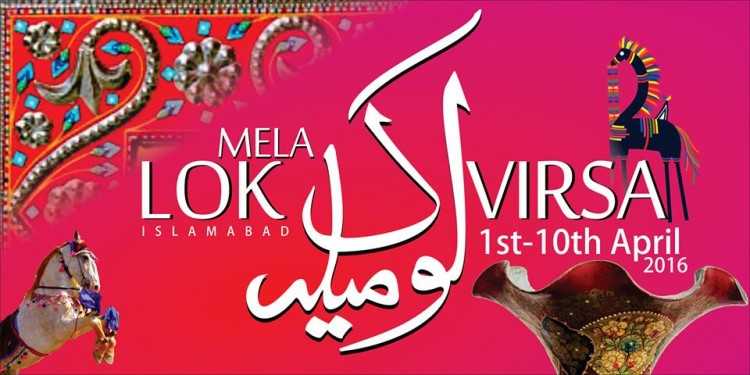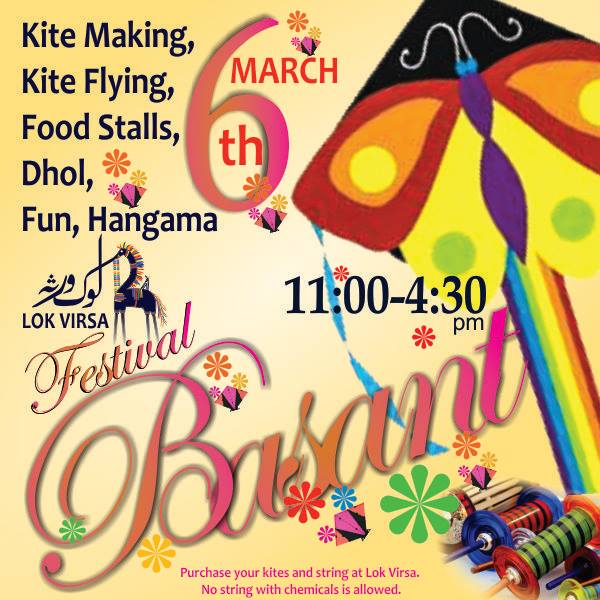Basant at Lok Virsa making Islamabad a colourful city
Islamabad, Pakistan: Islamabad is known for its social dullness among people of Lahore and Karachi but National Institute of Folk and Traditional Heritage, Lok Virsa is making a real colourful city indeed.
Cloudy Sunday made Festival more colourful at Lok Versa on the last day of Chunri and kite making training programme. A large number of people especially youth and families from the twin cities of Islamabad-Rawalpindi attended the festival and enjoyed special activities hosted by Lok Virsa.
The 6-day training programme in Chunri (Tie and Dye) and Kite Making: Engagement with Artisans marking Basant celebrations was part of the series of programmes that Lok Virsa is currently holding under the title “Craft of the Month” with the objective to promote traditional skills, giving knowledge to younger generation about the importance and utility of different crafts and provide opportunity to youth to learn about Pakistan’s rich, diverse and pluralistic cultural tapestry.
It also encourages youth to value dignity of labor, foster ownership for their culture, create respect for different professions and character building. It helped understand the contribution of artisans in the sustainable development of their community and country at large.
As many as hundred children and youth studying in various schools and colleges working under the administrative control of Federal Directorate of Education (FDE), Directorate of Special Education, Iqra University and other institutions participated in
the programme apart from children of the visitors to Lok Virsa museums and learnt craft making techniques from master trainers and artisans between March 1-6, 2016 at Pakistan National Museum of Ethnology “Heritage Museum. Master artisans, who imparted training to youth in Chunri (Tie and Dye) were Ameer Mai, Shamim Mai, Razia Bibi and Muhammad Farhan, whereas the kite makers included Muhammad Qaiser, Muhammad Nasir and Abdul Basit. All these artisans hailing from Southern Punjab possessing a vast knowledge and experience of association with the profession, were nominated by Cholistan Development Foundation, Bahawalpur for this particular training program.
Sharing her experiences, 60-year old Chunri artisan from Cholistan Ms. Ameer Mai said “I learnt this art from my mother at the age of 5. She was also an excellent chunri maker. In our community, ladies do this work with utmost dedication. I have trained around 25 girls, who have now enough knowledge to transfer this art to others. For me, it was a unique experience for me to teach Chunri making techniques to children”. Another artisan Shamim Mai told that the idea of providing training classes to children is excellent. She said “though I trained young girls in my native town in Bahawalpur but holding training classes with children of a developed urban area like Islamabad was a memorable task for me. They have even given me ideas and suggestions how can I make new innovations in my craft.
Dr. Fouzia Saeed, Executive Director, Lok Virsa said, “Pakistani children have a great potential to learn knowledge about our rich craft heritage”.
Chunri (Tie and Dye) is one of the traditional dying crafts of Pakistan. It began about 5,000 years ago and called as bandhani or Chunri. This technique involves tying small dots with thread all over the fabric to create designs and motifs.
After tying, the fabric is dyed then the ties are removed and a beautiful pattern forms on the fabric. Most popular material to use is cotton as it is soft and easy to handle. Regarding kite making, it is believed that the art originated from China and then it found its roots in the entire South Asia including Pakistan.



